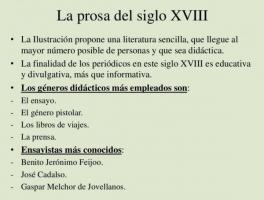The MAIN themes of Romanticism
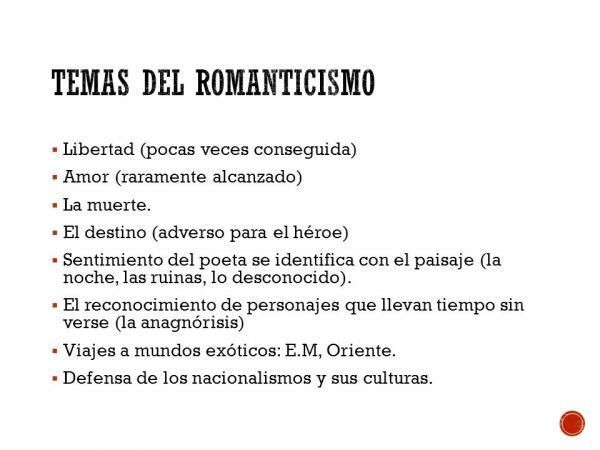
Image: SlidePlayer
The movement of Romanticism arose with the aim of positioning emotions and feelings in a narrative and artistic foreground. Until now, the Enlightenment and Neoclassicism had invaded everything and, therefore, a rational and scientific worldview was what predominated the most. However, in the eighteenth century a new artistic and literary trend that separated from enlightened objectivity to opt for a more subjective, deep and intense type of texts that spoke from the depths of being human. To better understand this artistic and cultural movement, in this lesson from a PROFESSOR we are going to discover the themes of Romanticism most prominent and cultivated.
Although there were many themes of Romanticism, it is true that the authors focused mainly on some themes and some environments that predominated in their writings. This caused that, little by little, a romantic atmosphere which, nowadays, is very easy to recognize.
Here we will discover the most cultivated topics during the romantic era:
Emotional and sentimental literature
One of the themes that appears most in romantic works are themes that directly touch emotions and feelings. And it is that, in this current, the "I" was positioned in a narrative foreground to speak from him and about him. The human being and his emotions began to be the narrative axis of many authors of the time who, thanks to literature, they could know themselves better and inquire into the depths of their soul and their mind.
Importance of imagination
Let us remember that one of the characteristics of Romanticism is that it is a movement that seek freedom in every way: creative freedom, mental freedom, emotional freedom and even socio-political freedom. This search for freedom also affects the mind and, therefore, the romantic author unleashes his imagination to recreate dream worlds full of fantasy and supernatural elements. Reality takes a back seat to give way to a more personal, metaphorical and free world.
Praise for childhood
Another of the most frequent themes of Romanticism is the allusion to childhood as a period full of wisdom and innocence. The romantic poet has a pessimistic character, defeated, the reach of maturity has made him see how hard life is and the pain that he can feel. Therefore, the period of childhood is evoked as a time of pure innocence and, therefore, of happiness. This stage is idealized and he feels nostalgic for her and for the inexorable passage of time.
The importance of nature
Nature in Romanticism ceases to occupy a passive and merely spatial plane to become a theme in itself. And it is that one of the most characteristic elements of romantic literature is that the authors personalize natural environments and link the emotions of their protagonist with the state of the nature. For the romantics, nature is the spirit of the universe and, therefore, it has a great connotation in the works of this time.
The feeling of nostalgia
We have already indicated that the romantics viewed life from a pessimistic and somewhat bleak prism. The suffering they suffered from emotional swings made many of them not want to continue living. Therefore, the feeling of nostalgia, that "any past time was better" is a constant in romantic literature. They feel nostalgic for the past but also for everything that was not and with this tone many of the great works of the genre are presented to us.
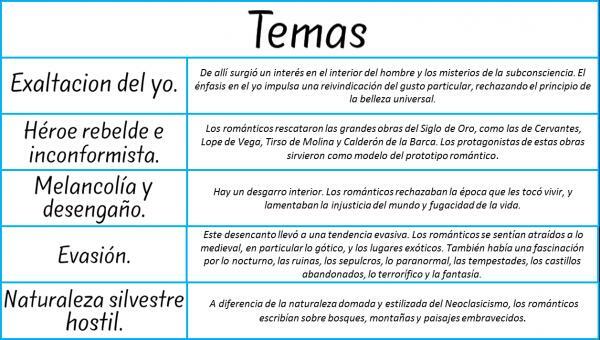
Image: romanticismosentimientos.blogspot.com
Now that we have known in general terms what were the great themes of the authors of Romanticism, it is important that we focus on the Spanish romantic authors and that we know what topics they preferred to deal with. In addition to those already mentioned above, the literati spoke of other topics such as:
- Middle Ages: in 18th century Spanish literature we find that many authors set their novels and his creations in the Middle Ages since he was considered to have a past time in which everything was best. This period in history is also a response to Neoclassicism that, during the previous century, focused on setting its works in the Classical Age.
- Mysticism and spirituality: in Romanticism we also find a great presence of mystical and spiritual themes. Religion is also part of romantic texts but faith is usually lived in a more personalized, more mystical way, as the scope of light and truth individually.
- Cult of death: this theme is typical of the entire romantic movement but it also had a strong presence in Spain. And it is that during this time he was curious about everything that is not seen, about spirituality and, therefore, about death. In addition, many romantics felt a great rejection of life and the cult of death became their most effective response.
- Historical themes: We must not forget that the romantic movement was the movement that originated the appearance of nationalisms. This happened precisely because of the search for individuality and freedom. These concepts went from the personal to the collective level and, now, nations and societies wanted to vindicate their personality, their traditions, their language, their culture, and so on. For this reason, history was another of the most cultivated themes of Romanticism in Spain but also in many other countries of the world.
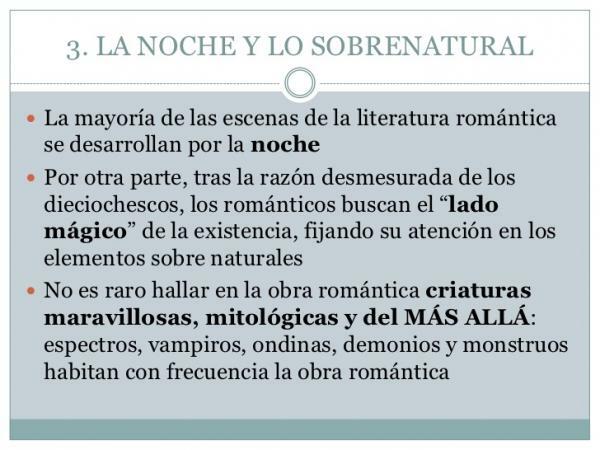
Image: Slideshare
The nationalism that arose with Romanticism was very important in Hispanic American literature since, at that time, it was still colonized by countries such as Spain, Portugal or England. The romantic current was the trigger for Hispanic America to begin to defend its cultural and historical legacy and to begin the emancipation movements.
Due to the great importance that Romanticism had in this part of the world, below we will analyze which were the topics most discussed by the authors of the Spanish-American countries.
- Traditional themes: In Latin America there were two reactions to the nationalist spirit of the romantics and one of them was the one that decided to defend the values of Catholics as their own. They were authors who felt totally Catholic.
- Revolutionary texts: The second reaction that took place among Spanish-American authors was to rebel against the imposed religion and begins to inquire about his own roots, the beliefs of his people and their traditions.
- The freedom of the individual: This was one of the hottest Romantic themes among Spanish-American authors. And this freedom not only went beyond the individual context but also referred to the collective, to the need to liberate itself as a nation.
- Patriotism: influenced by French authors such as Victor Hugo, many romantics began to feel a strong patriotic feeling towards their roots, their culture, their traditions, and so on. And this can be clearly seen in the novels and texts created at the time.
- The Indian and the Slave: is another of the most characteristic themes of this literature. And it is that the search for freedom made the authors realize the reality that was lived in their country and the great social inequalities that existed in the community. For this reason, they began to give prestige to the Indians and introduced indigenous themes as well as characteristics of their speech and customs in their works.
Gaucho poetry
To conclude this lesson, it is important to talk about gaucho poetry, a type of lyric that appeared in Latin America, especially in Argentina. The gaucho was a great source of inspiration for romantics and, therefore, there are two key works about them:
- Facundo(1845) published by Faustino de Sarmiento. It is a romantic novel in which the gauchos are presented as the symbol of traditional force and against the rules of supposedly civilized society. A negative and anti-progressive vision of the gauchos is shown.
- Martin Fierro (1872 and 1879) by José Hernández. Unlike the previous work, in this one we are presented with a character who becomes the victim of the central authority. They are two long narrative poems in which the author shows us the values and way of life of the gaucho and he does everything with a tone of maximum respect and admiration.
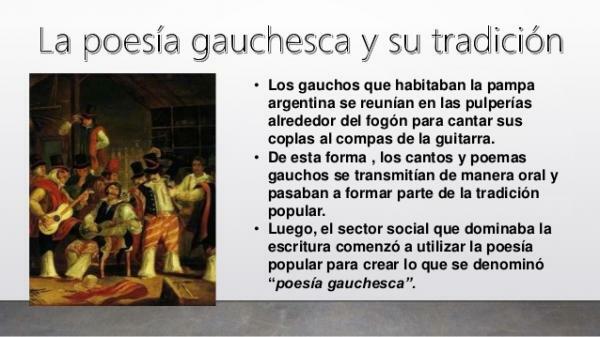
Image: SlideShare

